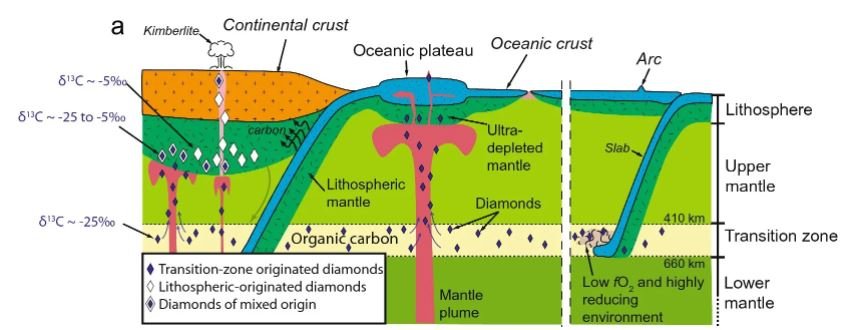Rare Diamonds Emergence
Despite humanity’s infatuation with glittering carbon particles, there appears to be much more to discover about how rare diamonds grow deep within our globe.
According to new research published in the journal Scientific Reports, two different types of rare diamonds have the same origin storey – the recycling of once-living species over 400 kilometres (250 miles) beneath the surface.
Natural diamonds are divided into three categories. Lithospheric diamonds, for example, occur in the lithospheric layer roughly 150 to 250 kilometres (93 – 155 miles) below Earth’s surface. These are by far the most prevalent and are more likely to be found in an engagement ring.
Then there are the oceanic and super-deep continental diamonds (both extremely rare).
Deep Continental Diamonds
Deep continental diamonds are formed between 300 and 1,000 kilometres (186 and 621 miles) below the Earth’s surface, whereas oceanic diamonds are discovered in oceanic rocks.
To put that in context, space is defined as 100 kilometres (62 miles) above sea level, the International Space Station orbits around 400 kilometres (250 miles) above Earth, and humans have never dug deeper than 12.2 kilometres (7.6 miles) into the ground. As a result, super-deep continental diamonds occur deep within the Earth’s mantle.

Oceanic and super-deep continental diamonds appear to be quite distinct, as one might expect. Because the fluctuation in a carbon isotope signature known as 13C (delta carbon thirteen) may be used to distinguish whether carbon is biological or inorganic, previous studies have speculated that oceanic diamonds were produced from organic carbon that was formerly found within living beings.
The amount of 13C in super-deep continental diamonds, on the other hand, is exceedingly varied. It’s difficult to discern whether or not they’re formed of organic carbon.
However, the research lead by Curtin University geologist Luc Doucet discovered that super-deep continental diamond cores have a similar 13C composition. Surprisingly, like oceanic diamonds, this means that these gems also include the remains of once-living animals.
“This research found that Earth’s engine truly transforms organic carbon into rare diamonds many hundreds of kilometres below the surface, giving new meaning to the old trash to treasure proverb,” added Doucet. “Mantle plumes, or ballooning rocks from Earth’s deeper mantle, transport rare diamonds back to the surface via volcanic eruptions for humanity to enjoy as sought-after gemstones.”
Some of these deep diamonds return to the lithosphere as cores surrounded by inorganic diamond crusts with isotopes that match the diamonds from the lithosphere. This helps to explain why their 13C content varies so much.
We’ve learned a surprising amount about scientists’ second favourite kind of carbon in recent years.
Pressure Resistance
The structure of these crystals stays intact even at pressure five times higher than Earth’s core, and in 2019, we even discovered a diamond with a complete other diamond inside it.
But, by no means, is this new research the end of the storey. Scientists are baffled as to why these deep, rare diamonds discovered deeper than the lithosphere use recycled organic carbon.
“It could be related to the physical-chemical environment there,” said Zheng-Xiang Li, a geologist at Curtin University. “It’s not unusual for a new scientific discovery to create fresh questions that need to be investigated further.
